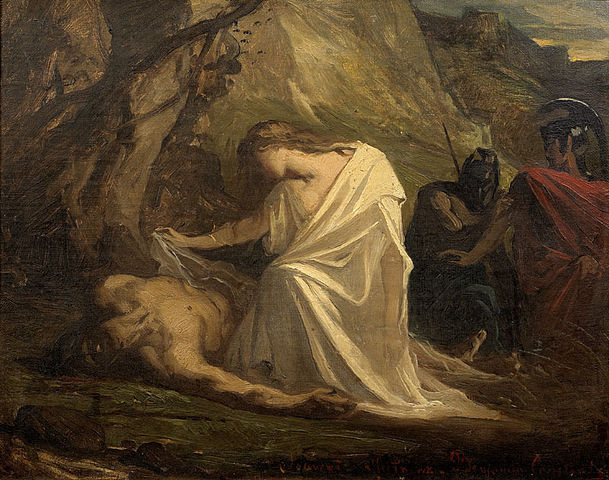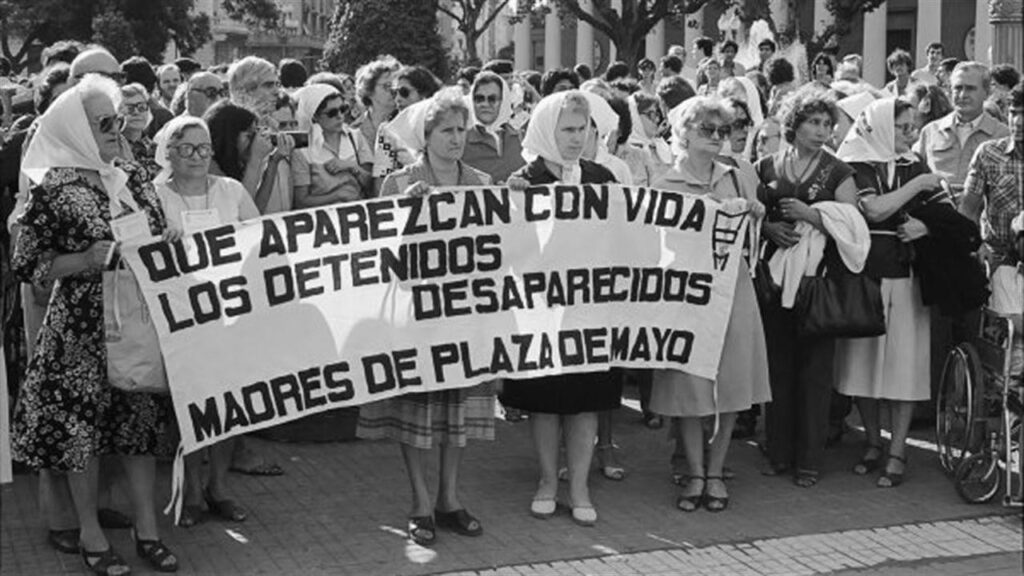
Sophocles’ Antigone
Written in around 441 BC, this ancient Greek tragedy has been around for quite literally centuries. In Sophocles’ plot, Antigone defies the orders of the king, Creon, by performing burial rites upon the body of her brother, Polynices. This had been forbidden by Creon as punishment for Polynices challenging his brother, Eteocles, with whom Creon sided in their dispute for power. Antigone stands by her decision when presented before Creon and so is sentenced to death, despite being engaged to his son, Haemon. Creon is warned by a prophet that it is a grave error to kill Antigone and refuse to bury Polynices properly, but he ignores both this warning and Haemon’s pleas and has her sealed within a tomb to starve to death. However, when a prophet tells him that the punishment will be the death of his child, he relents and hurries to release her. It is too late. Antigone has hung herself, Haemon kills himself and Creon’s wife, Eurydice, then also commits suicide.
A grim plot – this tragedy hardly seems conducive to peace building. Indeed, within the technical conventions of ancient tragedy, Antigone is not even the tragic hero of this play; it is Creon. She is a figure of defiance, representing a woman who has betrayed the traditional role of women in Ancient Greece by speaking against authority. In this way, she would seem most likely to be visualised as a figure of violence. [1]
However, modern responses to this tale speak differently. Antigone has become the main protagonist of many retellings and, through this, the tale of a woman’s defiance against a tyrannical leader has been repeatedly adapted within the context of contemporary conflicts, particularly within the 20th century. In fact, her defiance has taken on a pacifist slant as Antigone has become an icon for truth and redemption and an end to violence. To explore this, I will examine three specific examples: Antígona Furiosa (Griselda Gambaro, 1986), Antigone (Jean Anouilh, 1944) and Antigone (Bertolt Brecht, 1948).
Gambaro’s Antigone

A highly political Argentinian writer, Gambaro wrote her version of Antigone, Antígona Furiosa (‘Raging Antigone’), in the tumultuous aftermath of the dictatorship of Jorge Rafael Videla (1976-1981). Under this dictatorship, crimes against humanity were repeatedly committed by his government. Around 30,000 people (los desaparecidos) disappeared without a trace, presumably to be tortured, killed or sent to prison camps. As such, Gambaro staged her Antigone during the period known as El Proceso in which those affiliated with Videla’s rule were put on trial for their crimes.
In Gambaro’s version of the tragedy, the focus is shifted almost wholly to the character of Antigone and the play begins with her suicide. She spends most of the play talking to two men, characters conceptualized by Gambaro, who mock her fate, suggesting ‘who holds a loved one dearer than her country is despicable.’ These men imitate the roles of Creon and Haemon, creating an re-enactment of Sophocles’ tragedy trapped within the inevitable sphere of Antigone’s fate, since Gambaro’s play is framed by her suicide. Through this technique, her re-working elevates the sense of Antigone’s entrapment and desperation.
‘I would write with the voice of an Latin American, Argentinian woman… who in Argentina had tried to do the same as Antigone: disobey the ominous power and bury their dead.’
Griselda Gambaro
For Gambaro, as articulated in the quote above, her Antigone specifically represents ‘Las Madres de la Plaza de Mayo.’[2] These women serve as a key example of peaceful protest, since every Thursday they would silently protest in the Plaza de Mayo in Buenos Aires for the return of their children who had been taken from them. The comparison here is obvious; Antigone wishes to bury her dead, as do the mothers. The cyclical fate of Gambaro’s Antigone reflects the seemingly interminable protesting of the mothers. In this way, Antigone’s determination to process her grief finds real footing in an Argentinian context; her defiance becomes a matter of post-conflict justice; and her refusal to back down in the face of patriarchal oppression can be viewed as a key step in a peace-building process.[3]
Anouilh’s Antigone
‘Have you ever thought how lovely a garden is when it is not yet thinking of men?’
Anouilh’s Antigone
An extremely varied French dramatist, Anouilh’s adaptation of Antigone has become his most well-known work, mostly by virtue of the fact that it was staged and, indeed, premiered in Nazi-occupied France. As a result, this play is associated with the La Résistance (the grassroots French opposition to the Vichy government).
In Anouilh’s version, Antigone is the primary character, as for Gambaro, but Creon is also presented with nuance. He adopts a bureaucratic political rhetoric to explain in measured terms to Antigone why he cannot bury Polynices, arguing that he and his brother were both to blame for the conflict, but someone had to be made into an example.
Antigone herself is much less violent and tortured than the Antigone of Gambaro; Anouilh invents the character of Antigone’s nurse, a move which helps portray her as on the cusp of adulthood, lending her an innocence and perhaps explaining some of her idealism. In crucial criticism by W. Calin, he suggests her characterization is bird-like. This is interesting, considering images of birds often connote freedom and, indeed, peace. [4] Contemporary critic Rosamund E. Deutsch suggests that, by removing Antigone’s religious motivation for the burial of her brother, Anouilh brings to the forefront Antigone as a woman fighting for personal liberty in her actions. [5] This would highlight Antigone as a modern symbol of peace, since in a contemporary context the religious necessity of burial would have been less prominent, whereas the desire for personal freedom in a country under occupation would have been critical.
Anouilh’s Antigone is much less explicitly drawn than Gambaro’s in terms of its criticism of one specific regime; after all, Anouilh’s Creon presents reasonable arguments as to why Polynices cannot be buried. However, the simple act of setting a play that is concerned with a tyrannical ruler and a one-woman rebellion in a Nazi-occupied France has led to the widespread consensus that Antigone is an allusion to the French Resistance. As Deutsch further points out, Anouilh’s Creon does not break down at the news of the suicides but calmly continues with his orders of business, replicating the cruel and state-focused efficiency of modern dictators. Therefore, if Creon represents the modern dictator, Antigone must represent those who push back against tyranny.
Brecht’s Antigone
‘It may, therefore, not exactly be easy to make progressive art, especially at the time of re-building. This ought to spur us on.’
Brecht’s preface to his Antigone
Potentially the most well-known playwright on this list, German-born Bertolt Brecht, spent much of his career in exile from Nazi Germany. As such, he wrote and staged his Antigone from Switzerland. Therefore, he has much in common with Anouilh (in Nazi-occupied France) and Gambaro (just returned from her own war-time exile). Whilst Brecht’s Antigone remains quite close to the original, it begins with a prelude explicitly linking it to its historical context, in which two sisters in Berlin return from an air raid shelter, find their brother killed for deserting the military, and are questioned by an SS man (the organization under Hitler primarily responsible for the Holocaust). Therefore, Brecht is very explicit about the context within which his Antigone is set.

The critic Frank Jones notes that the condemning of Creon’s impiety is replaced by Brecht with the condemnation of his inhumanity, updating the play so that it resonates further in its historical context of Nazi dictatorship.[6] Like Deutsch’s criticism of Anouilh’s version, Jones notes that for a contemporary audience Creon’s biggest crime would not have been his disobeying of the gods but his disobeying of morality, showing a similar re-working of Sophocles’ play to condemn a tyrant through more modern issues.
In his preface, Brecht talks of the censorship of theatre under the Nazis and, in the quotation above, the subsequent need for theatre as a response. In this way, as for Gambaro and Anouilh, not only does Brecht’s Antigone oppose a brutal dictator and so represent an anti-war stance in this way, but the medium of the theatre itself becomes a space of defiance, since Brecht has adapted this play from a place of exile.
In summary, Antigone has become much more than its Ancient Greek could perhaps have imagined, in the way it has been adapted by many playwrights impacted by brutal conflict. It is fair to say that the number of times this has occurred means the play must resonate with a voice seeking reconciliation or a modern portrayal of resistance to tyranny. It cannot be a coincidence that these playwrights, who themselves were impacted by political exile, turn to Sophocles. The importance of context to all three of these productions highlights how useful the medium of theatre can be for visualizing peace: contemporary audiences are brought together in watching the productions, allowing Antigone – as a figure who disobeys authority – to become a symbol of topical rebellion by virtue of the context in which her story is placed. To take this further, by criticizing a tyrannical leader from a place of exile or censorship, these playwrights represent ‘Antigone’ figures themselves, since they are resisting the burial of a political narrative by telling a truth that cannot be said outright in their own country.
What do you think?
- Does Antigone resonate with you as a symbol of resistance?
- In what ways can resistance connect with peace-building?
- How might the figure of Antigone prompt us to reassess assumptions about violence and peace?
- Can you think of other re-tellings of Greek tragedies within modern day conflicts which help us re-visualise war and peace?
- Is theatre an effective form of storytelling to reflect on conflict and peace-building? Does it have its disadvantages? What other forms of storytelling can be effective?
If you enjoyed this item in our museum….
You might also enjoy Andromache’s search for post-conflict peace, A Manufactured Image/With No Philosophies: Art and Peace in Head (1968), and Colombia: The long road to peace.
Christy Forshaw, May 2023
[1] More on Sophocles’ Antigone, as well as Antigone as a figure, can be found here https://womeninantiquity.wordpress.com/2018/11/19/antigone/
[2] More on Las Madres de la Plaza de Mayo can be found here: https://www.learningforjustice.org/classroom-resources/texts/madres-de-plaza-de-mayo
[3] If looking for further critical commentary on Gambaro’s version of Antigone, this article provides a very interesting overview: https://themagdalenaproject.org/sites/default/files/OP3_Gambaro.pdf
[4] There is much criticism available of Anouilh’s Antigone, but this review provides a good starting point:
[5] Rosamund E. Deutsch’s full review can be found here: https://www.jstor.org/stable/pdf/3292337.pdf?refreqid=excelsior%3A034a48d243dd90917565312e28b3b9f2&ab_segments=&origin=&initiator=
[6] Frank Jones provides a good starting point for commentary on Brecht’s Antigone: https://www.jstor.org/stable/1124792